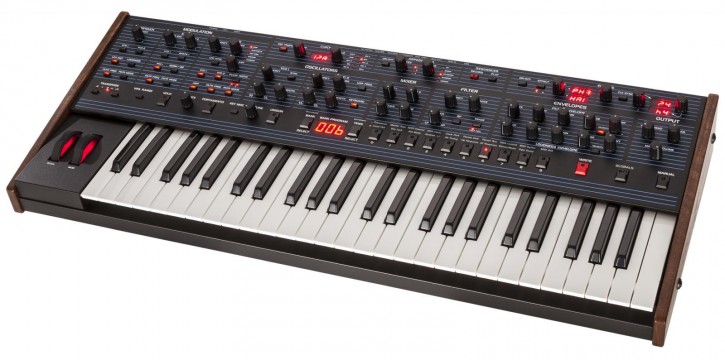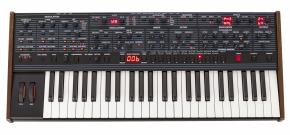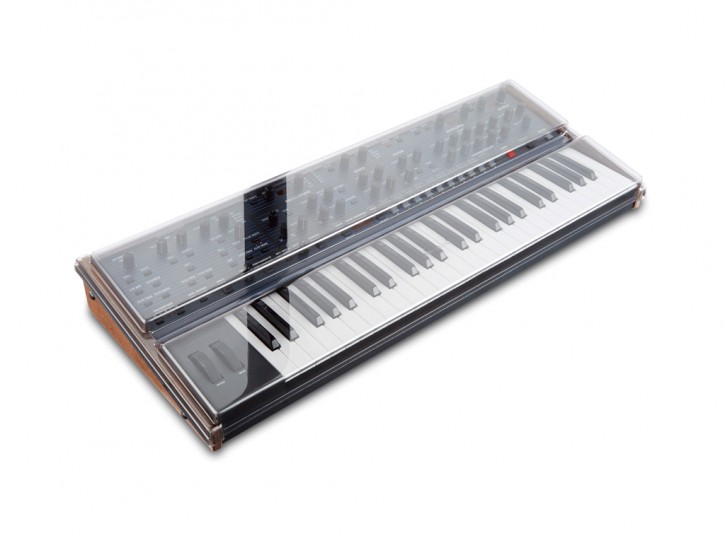Um eine Bewertung zu schreiben müssen Sie angemeldet sein.
Um eine Bewertung zu schreiben müssen Sie angemeldet sein.
Um eine Bewertung zu schreiben müssen Sie angemeldet sein.
Um eine Bewertung zu schreiben müssen Sie angemeldet sein.
Um eine Bewertung zu schreiben müssen Sie angemeldet sein.
Um eine Bewertung zu schreiben müssen Sie angemeldet sein.
Um eine Bewertung zu schreiben müssen Sie angemeldet sein.
Um eine Bewertung zu schreiben müssen Sie angemeldet sein.
Um eine Bewertung zu schreiben müssen Sie angemeldet sein.
Um eine Bewertung zu schreiben müssen Sie angemeldet sein.
Um eine Bewertung zu schreiben müssen Sie angemeldet sein.
Sequential Tom Oberheim OB-6
Hersteller: Sequential (Dave Smith)
Weitere Informationen:
http://www.sequential.com/product/ob-6/
3560,00 CHF
Produktbeschreibung
OB-6 Analog Synthesizer
Legendary Poly Synth Creators Team Up on New Instrument with Discrete VCOs and Filters
Anaheim, CA—January 21, 2016—Dave Smith Instruments today announced the
OB-6,a new 6-voice synthesizer with an all-analog signal path and discrete VCOs and filters
developed in collaboration with Tom Oberheim.
Boasting a sound engine inspired by Oberheim’s original SEM (the core of his acclaimed 4-voice and 8-voice synthesizers), the new instrument is designed to provide true, vintage SEM tone with the stability and flexibility of modern technology.
Said Smith: “Tom and I have been friends and friendly competitors since the late 1970’s. Back in the day, people were typically in either the Prophet or the Oberheim camp.
Now, with the Prophet-6 out and doing so well, we thought it would be fun to combine our strengths and bring back Tom’s classic polyphonic sound, too — in a modern format.
” Added Oberheim: “A lot of people, myself included, have always felt that the SEMs had a certain uniquely big, organic sound unlike anything else.
Working with Dave to make that sound widely available again with some modern touches and full programmability has been real a pleasure.”
The OB-6 features two discrete voltage-controlled oscillators (plus sub-oscillator) per voice, with continuously variable waveshapes (sawtooth and variable-width pulse, with triangle on oscillator 2).
There is a classic SEM- inspired state-variable filter (low-pass, high-pass, band-pass, and notch) per voice. Voltage-controlled amplifiers complete the all-analog signal path.
“The classic, bold SEM sound is all there,” said Oberheim.
Present also is X-Mod, with filter envelope and oscillator 2 as modulation sources (with bi-polar control). Destinations include oscillator 1 frequency, oscillator 1 shape, oscillator 1 pulse width, filter cutoff, and filter mode. The knob-per-function front panel puts virtually all parameters at a user’s fingertips. Toggling on the Manual switch enables live panel mode, in which the OB-6 switches to the current settings of its knobs and switches.
A dual effects section provides studio-quality reverbs, delays (including standard and BBD), chorus, and faithful recreations of Tom Oberheim’s acclaimed phase shifter and ring modulator.
The effects are digital, with 24-bit, 48 kHz resolution, but a true bypass maintains a full analog signal path.
Additionally, the OB-6 features a multimode arpeggiator and a polyphonic step sequencer with up to 64 steps (and up to 6 notes per step) plus rests.
It allows polyphonic keyboard input and can sync to external MIDI clock.
The full-size, four-octave, semi-weighted keyboard is velocity and aftertouch sensitive.
Said Dave Smith, “As with the Prophet-6, we made size a primary concern on the OB-6.
It’s the right mix of power and portability and it fits right in on-stage or in the studio.” Added Oberheim,
“And of course, it’s got that unmistakable SEM sound that’s going to turn a lot of heads. ”
The OB-6 is manufactured and sold by Dave Smith Instruments.
Launched in 2002, Dave Smith Instruments LLC is helmed by legendary musical instrument designer and
Grammy® award winner Dave Smith.
Dave’s many accomplishments include the creation of the Prophet-5—the world’s first fully programmable polyphonic synthesizer—and his legacy as the primary driving force behind MIDI (Musical Instrument Digital Interface).
Dave Smith Instruments’ products are used by an ever-growing roster of well-known musicians and are available from music retailers worldwide.
Instruments include the Prophet-6, Pro 2, Prophet 12, Prophet ‘08, Mopho x4, and the Tempest analog drum machine.
Dave Smith Instruments is based in San Francisco, where the instruments are also manufactured. For more information, visit www.davesmithinstruments.com.
About Tom Oberheim
The creator of the world’s first commercially available polyphonic synthesizers, Tom Oberheim has been responsible
for some of the most acclaimed and sought-after electronic instruments ever.
These include the original Oberheim 4-voice and 8-voice synthesizers, the OB-X, OB-Xa, and OB-8, as well as the Matrix 12 and Expander.
After a hiatus from instrument design, Tom is once again building synthesizers through his company, Marion Systems.
OB-6 Specifications
OSCILLATORS
Two discrete VCOs per voice
Continuously variable wave shape (sawtooth and variable-width pulse, plus triangle on oscillator 2) per oscillator
Pulse width per oscillator
Hard sync: oscillator 1 syncs to oscillator 2
Square wave sub-octave generator (oscillator 1) per voice
Low frequency mode (oscillator 2)
Keyboard tracking on/off (oscillator 2)
Oscillator detune amount for increased tuning instability, from subtle to extreme
MIXER
Oscillator 1 amount
Oscillator 1 sub-octave amount
Oscillator 2 amount
White noise amount
STATE-VARIABLE FILTER
Two-pole, resonant, filter per voice with low-pass, high-pass, band-pass, and notch functionality inspired by the original Oberheim SEM filter
Bi-polar filter envelope amount
Velocity modulation of envelope amount
Keyboard tracking: off, half, full
FILTER ENVELOPE
Four-stage (ADSR) envelope generator
Velocity modulation of envelope amount
AMPLIFIER ENVELOPE
Four-stage (ADSR) envelope generator
Velocity modulation of envelope amount
LOW FREQUENCY OSCILLATOR
Five wave shapes: sine, sawtooth, reverse sawtooth, square, and random (sample and hold)
Clock sync (internal or external MIDI clock)
Initial amount
Mod destinations: oscillator 1 frequency, oscillator 2 frequency, oscillator 1 and 2 pulse width, filter cutoff, filter mode, amp
X-MOD
Sources: filter envelope (bi-polar) and oscillator 2 (bi-polar)
Destinations: oscillator 1 frequency, oscillator 1 shape, oscillator 1 pulse width, filter cutoff, filter mode, normal to bandpass filter
AFTERTOUCH
Source: channel (mono) aftertouch with bi-polar amount
Destinations: oscillator 1 frequency, oscillator 2 frequency, LFO amount, amplifier envelope amount, filter envelope amount, filter mode
CLOCK
Master clock with tap tempo
BPM control and display
MIDI clock sync
ARPEGGIATOR
Selectable note value: 16th note, 8th note triplet, 8th note, dotted 8th note, quarter note
One, two, or three octave range
Up, down, up/down, random, and assign modes
SEQUENCER
Polyphonic step sequencer with up to 64 steps and rests
EFFECTS
Stereo analog distortion
Dual, 24-bit, 48 kHz digital effects, including: reverb (room, hall, plate, spring), delay (full bandwidth digital delay and emulated bucket brigade), chorus, flanger, phase shifters, and ring modulator
Delay sync
True bypass maintains fully analog signal path when digital effects are off
PERFORMANCE CONTROLS
Full-sized, semi-weighted, 4-octave keyboard with velocity and aftertouch
Backlit pitch and mod wheels
Spring-loaded pitch wheel with selectable range per program (1 to 12 semitones up and down)
Transpose controls for an 8-octave range
Hold switch latches held notes on
Polyphonic portamento
Unison (monophonic) mode with configurable voice count, from one to all six voices, chord memory, and key modes
Manual switch: when on, the front panel is live; what you see is what you hear
PATCH MEMORY
500 user and 500 factory programs in 10 banks of 100 programs each
Direct program access, including single-button access to the current set of 10 programs
IN/OUT
Left/mono and right audio outputs (2 x 1/4” phone jack)
Headphone output (stereo, 1/4” phone jack)
MIDI in, out, and thru ports
USB for bidirectional MIDI communication
Filter cutoff expression pedal input
Volume expression pedal input
Sustain footswitch input
Sequencer start/stop footswitch input
POWER
IEC AC power inlet for internal power supply
Operates worldwide on voltages between 100 and 240 volts at 50 to 60 Hz; 30 watts maximum power consumption
PHYSICAL SPECS
31.8” L x 12.7” W x 4.6″ H (80.7 cm x 32.3 cm x 11.7 cm)
20 lbs (9.5 kg)
Walnut end panels
Neues OS mit MPE Unterstützung und v.m
Neues OS für OB 6 1.6.6
New Features in OS 1.6.6
• Support for MPE (MIDI Polyphonic Expression). This enables the OB-6 keyboard and module to respond to MPE-driven controllers such as the LinnStrument®, Expressive E Osmose®, and Roli Seaboard® series, to name just a few.
• Prophet-5 Rev 4-style “vintage” mode. This gives the OB-6 a looser, more organic sound that emulates the behavior of vintage synthesizers where the behavior of individual oscillators, filters, and envelopes often vary from voice to voice.
• Improved aftertouch curves for enhanced expressiveness when using the OB-6’s own keyboard.
Weitere Informationen: http://www.sequential.com/product/ob-6/
Downloads
Bewertungen






